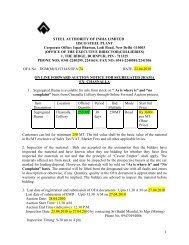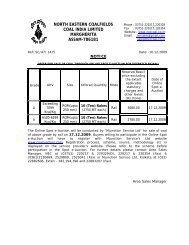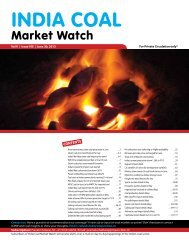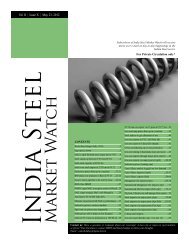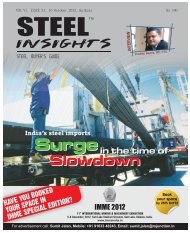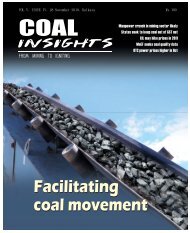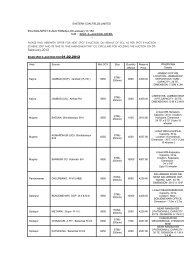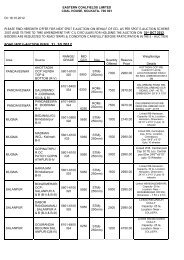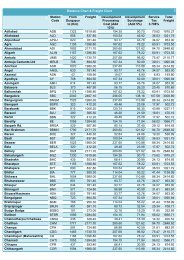India's largest coal handling agency - Mjunction
India's largest coal handling agency - Mjunction
India's largest coal handling agency - Mjunction
You also want an ePaper? Increase the reach of your titles
YUMPU automatically turns print PDFs into web optimized ePapers that Google loves.
Snap Shot<br />
It was finalised that the miners will wear sweaters because<br />
they will experience a shift in climate from about 90 degrees<br />
Fahrenheit underground to temperatures hovering near<br />
freezing point if they ascend at night. Those coming out during<br />
daylight hours were instructed to wear sunglasses. At the<br />
beginning after their discovery, the miners installed lights to<br />
simulate day and night to diminish the impact of their eventual<br />
return to the surface, supported by a 500-watt power line.<br />
The escape capsule<br />
In the last stage, three capsules were built to bring back each<br />
miner at a time, corresponding to the three rescue plans. The<br />
capsules had a common name, “Phoenix”, after the mythical<br />
bird which rose from the ashes, symbolising a sort of rebirth<br />
for the trapped miners. As per the plans, they were called<br />
Phoenix 1, 2 and 3. It was Phoenix 2 which finally rescued the<br />
trapped miners.<br />
The escape capsule, equipped with spring-loaded wheels<br />
to press against the hole's walls, was to be lowered into the<br />
hole by an slow speed electric winch and the trapped miners<br />
brought up one by one. The spring loaded wheels ensured<br />
that the capsule would not be jammed in the hole. The weight<br />
of each capsule was approximately 924 pounds or 420 kg.<br />
The safety department of the Chilean government had insisted<br />
on casing the whole shaft. But a technical decision, based on<br />
the evidence and the expertise of a team of eight geologists<br />
and mining engineers, was taken whether to line the whole<br />
shaft or part of it.<br />
Encasing the full shaft would have added another week<br />
or so before the rescue could begin and there was the added<br />
danger of pipes getting jammed.<br />
The political consequences of the pipe getting jammed<br />
were inescapable. Chile's success story would evaporate if a<br />
miner should get stuck on the way up for reasons that might<br />
have been avoided.<br />
Some miners' families wanted the entire shaft lined with<br />
pipe, but some engineers involved said the risk of the capsule<br />
getting jammed in the unreinforced hole was less than the risk<br />
of the pipes getting jammed and ruining their hard-won exit<br />
route. It was ultimately decided to encase only first 100 metres<br />
of the shaft.<br />
The trial run of the capsule was done a few times before<br />
men were allowed to enter the capsule.<br />
As it travelled down and up, down and up, the rescue<br />
capsule was not rotating as much inside the 2041-foot escape<br />
shaft as officials had expected, thereby allowing for faster<br />
trips.<br />
The final moment<br />
Eager family members and anxious strangers from around<br />
the world bit their lips in anticipation as the rescue operations<br />
began in the intense chill of the desert night.<br />
Sixteen minutes later, they broke out in cheers and chants<br />
of "Chile! Chile!" were heard as Florencio Avalos was the<br />
first to step out from the capsule. Avalos beamed as his<br />
feet touched the surface under which he was trapped for<br />
more than two months. He cradled his son and wife before<br />
Chilean President Sebastian Pinera bear-hugged him. Avalos<br />
appeared strong, walking without help and embracing many<br />
of the rescue workers who witnessed his arrival. He was then<br />
put on a gurney and wheeled away for an examination by<br />
doctors.<br />
In Chile’s capital Santiago, hundreds wept and embraced<br />
as they watched the rescue on a flickering big screen TV set<br />
up in a square. Champagne flowed at the Chilean embassy in<br />
Washington, D.C., too.<br />
The scene repeated itself several times as more and<br />
more miners arrived. Around the world, people, who were<br />
otherwise completely unrelated to the miners, sat glued to<br />
their television sets.<br />
Each round trip in the 924-pound Fenix capsule took<br />
about 50 minutes, and the last miner emerged on Wednesday,<br />
October 13.<br />
As the second miner, Mario Sepulveda, exited the rescue<br />
hole, he reached into a large yellow bag and handed out what<br />
appeared to be rocks to officials and rescue workers.<br />
Amid the sea of Chilean flags greeting the emerging miners<br />
was a collection of small, handheld Bolivian flags for Carlos<br />
Mamani, the lone Bolivian miner.<br />
His family back home was restrained for much of the<br />
morning while watching the rescue on TV. But they jumped<br />
up and clapped when they saw him kneel on the ground<br />
Next up was the youngest of the lot, Jimmy Sanchez, a<br />
19-year-old who worked as an environmental assistant and<br />
the father of a newborn girl.<br />
The first miners to come to the surface were deemed the<br />
most fit, but also possessed the most technical know-how so<br />
that they could advise the rescue teams.<br />
The next five were the physically weakest, a term perhaps<br />
not appropriate for anyone who has survived more than two<br />
months in the bowels of the earth. But one of the miners had<br />
diabetes; another had black lung.<br />
The last to come out was Luis Alberto Iribarren, 54 years<br />
of age. Like the captain of a sinking ship, the shift supervisor<br />
volunteered to stay behind until all his men were safe.<br />
"It's extremely exciting for us. ... It's a very emotional<br />
moment for us," said Jeff Hart, one of the lead drillers who<br />
assisted with the rescue efforts. "We worked real long and hard<br />
on that, and to actually see the capsule come through the first<br />
time through the hole that we drilled was just unbelievable."<br />
For the 33 men, the only contact with the outside world<br />
since August 5 was through a small bore hole through which<br />
they were sent food, water and other supplies. A letter sent by<br />
one of them said they would take a vow of silence, to never to<br />
fully reveal the details of their underground misery.<br />
High above the miners, about 1500 journalists from 39<br />
nations and family members held their collective breath, as<br />
the rescue effort went on. In the end, man won over the whims<br />
of nature, in an episode that will be remembered for a long<br />
time to come.<br />
COAL INSIGHTS 80 October 2010



